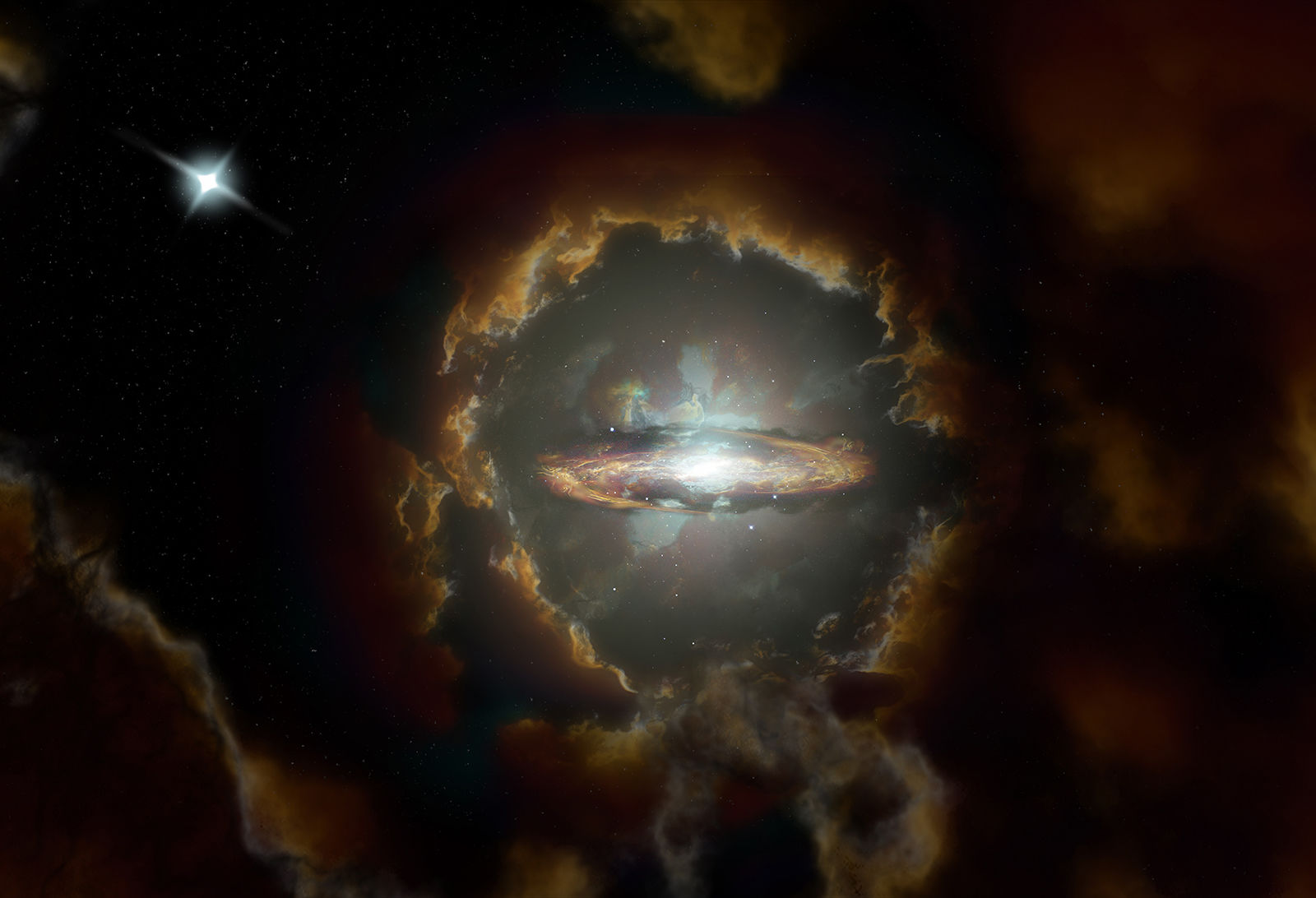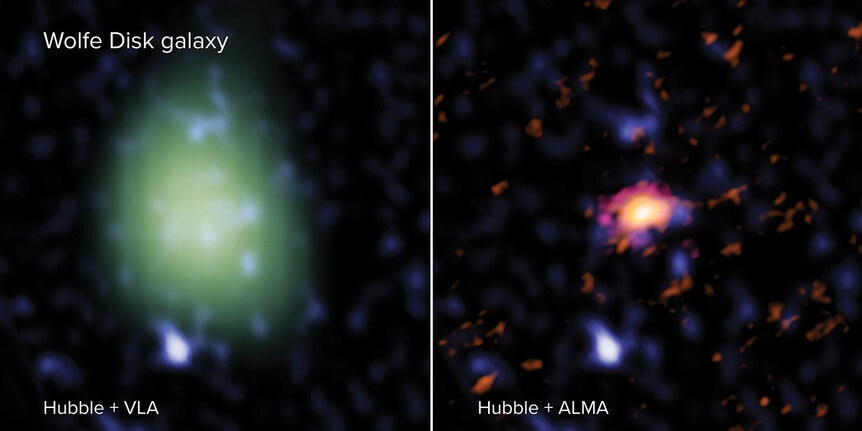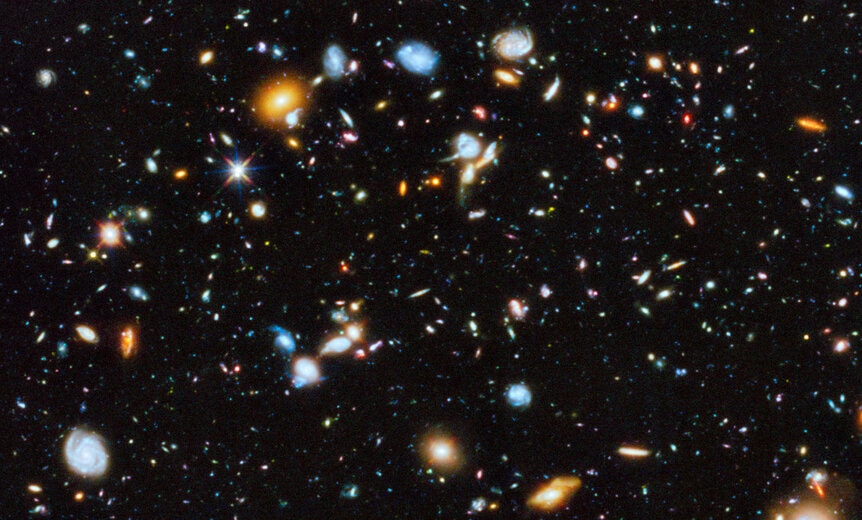Create a free profile to get unlimited access to exclusive videos, sweepstakes, and more!
How did this galaxy emerge from the chaos just 1.5 billion years after the big Bang?

Telescopes are time machines.
The farther away an object is, the longer it takes its light to get to us, so, in a sense, the farther in the past we see it. The most distant objects we see are so far away that their light took nearly the age of the Universe to reach us, so we see them as they were when the Universe was very young.
When we look at very distant galaxies (and therefore as they were when they were just getting started), we see that they are actually galaxy fragments: weird, distorted little things that are still growing. These fragments collide and merge with each other (further distorting their shapes for some time), eventually settling down into majestic elliptical and spiral galaxies like we see today. But, back then, they were still just irregular pieces.
Which is why it's so weird that astronomers just found what looks like a massive disk galaxy 12.3 billion light years away. In other words, this galaxy already had its act together less than 1.5 billion years after the Universe began! It's the most distant rotating disk galaxy ever seen.
The galaxy is called DLA0817g (nicknamed the Wolfe Galaxy, after the late Arthur Wolfe, an astronomer who was an advisor to several of the scientists who did this research), and it was observed with the Atacama Large Millimeter/submillimeter Array, a collection of dishes in Chile that observe light at much longer wavelengths than the human eye can see. It's sensitive to light emitted by things like singly ionized carbon (that is, carbon atoms missing one electron) and cold carbon monoxide gas, both abundant in galaxies. It can measure the speed that gas is moving (which also tells you the mass of the galaxy), and clearly saw evidence of the disk in the galaxy rotating at 270 kilometers per second, about the speed you'd expect for a large, massive, settled galaxy not too unlike our own Milky Way.
Hubble observations of the Wolfe Galaxy showed it has regions in it blasting out ultraviolet light, which is a sure sign that lots of stars are forming — some of those stars are very massive, and emit copious UV. The amount implies the galaxy is making stars at a rate of at least 16 times our own galaxy, and it could be far higher (the galaxy is dusty, and that blocks UV light; other indicators imply a star formation rate of over a hundred times the Milky Way's, which is a lot).
Traditional models of how disk galaxies form have a very difficult time producing such a galaxy. In those models gas falls into a forming galaxy, getting very hot, and shapes itself into a roughly spherical object that then cools and settles down into a disk. But that takes a several billion years, far longer than this galaxy has been around. Also, hot gas suppresses star formation, since the gas needs to cool before it can gather itself together to form nebulae and stars.
The astronomers who made these observations think that the galaxy grew in size by having cold gas falling into it. Instead of just slamming into the forming galaxy and heating up, it comes in at a rate the galaxy can assimilate, keeping it cooler. This idea has been gaining some traction in the past couple of decades.
But it has problems, too. Some of the gas may also come in as smaller, gas-rich dwarf galaxies merge with the bigger galaxy, too. But those are typically relatively violent events that heat the gas, making a cold disk hard to maintain. Clearly, there's more to learn about this process.
An interesting point about how this galaxy was found: Normally, deep surveys of the sky find the brightest examples of things first, since those are the easiest to find. But in this case the Wolfe Galaxy was found by accident. Astronomers were looking at an even more distant galaxy called a quasar, and saw that its light was being absorbed by cool gas a little closer to us. They took a look and found that gas was a part of the Wolfe Galaxy. Since the galaxy is relatively faint, that means that there may be many more big, well-formed disk galaxies in the early Universe.
Now the fun part is finding more of them. We'll need a lot more examples to understand all the processes that go into making galaxies like this. Was the Milky Way formed this way too? That would be a very interesting thing to know.
When we look into the distant Universe this way, we're seeking the clues to our own past, which will inform us of how we got here. That's one of the biggest questions we have, and I love that we're finding the answers.





























